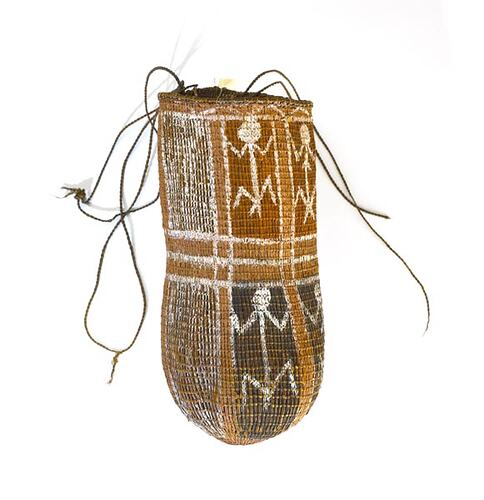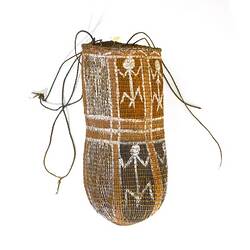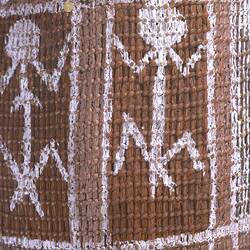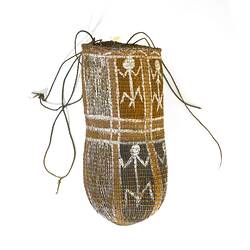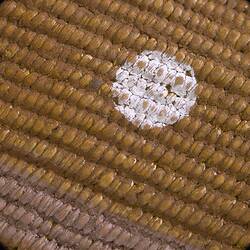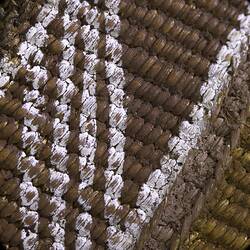Summary
The creation of fibre work has a long history in northern Australia. Images of dilly bags appear in the oldest sequence of rock paintings in western Arnhem Land, dating from around 20 000 years ago. Ancestors gave Aboriginal people fibre work, sacred versions of which are painted or decorated with feathers for ceremony. These decorated bags from western Arnhem Land are 90 years old. They are made of fibre produced from the dried and split leaves of the pandanus palm. Women across Arnhem Land continue to produce these bags, which are important cultural forms, enshrined in traditions of great artistry and detailed technical knowledge.
Conical baskets such as this one are of continuing significance to the Aboriginal people of western Arnhem Land. Images of baskets appear in the oldest rock paintings dated to about 20,000 years ago and conical baskets are still being made from pandanus today. For example, the artists of Gunbalanya (formerly Oenpelli), a community to the east of the East Alligator River and Kakadu, and the surrounding outstations, sell unique work at the arts centre at Injalak, including pandanus conical baskets made by Kunwinjku women. An important image in the rock art on Injalak Hill in western Arnhem Land is of the ancestor Yingarna who carries fifteen painted baskets like this one here. This is the only known image of Yingarna who came from the east and travelled on in a westerly direction before heading southwards. As she travelled Yingarna placed each basket at a specific location across the landscape and bining, as the people of western Arnhem Land refer to themselves, emerged from each basket to live and own that country. Yingarna gave each group a distinctive language and clan name.
Although the baskets were made by women and most likely painted by them too, they were made for men and used mainly to carry personal items as well as being for ceremonial purposes. The paint used on these baskets comes from natural pigments - mainly charcoal (black), pipe clay (white) and ochres (pale yellow to dark reddish-brown). To make paint, the source material was ground into powder with a pestle-type stone and mixed with a binding fluid. The paint would have been applied with a small stick or a brush made from hair for fine details or for larger coverage by brushing with a stick with a frayed end or direct application with the fingers.
Local Name
bulbbe
Physical Description
A twined conical basket made of pandanus close weave and painted with natural pigments.The multistrand handle of vegetable fibre string is attached to the rim at the rear. It is coated in yellow ochre and decorated with blocks of solid colour marked by lines in white pipe clay. Dynamic figures are painted on some sections.
Significance
This is one of three baskets painted with human figures that were collected by Baldwin Spencer from Gaagudju people camped at Oenpelli when he visited there in 1912. A fourth such basket was obtained for the museum in the following year and was sent by Paddy Cahill, who was the pastoralist at Oenpelli and with whom Spencer collaborated over the following decade. While similar dynamic figures are found in the ancient rock art galleries in western Arnhem Land, images of a conical basket painted with these figures is found in the rock art at Awunbarrna.
More Information
-
Object/Medium
Basket
-
Maker
-
Cultural Groups
-
Locality
Alligator River, Western Arnhem Land, Northern Territory, Australia
-
Date Produced
-
Collector
-
Date Collected
-
Object Measurements
580 mm (Length), 130 mm (Width), 105 mm (Height)
-
Keywords
-
References
[Book] Museum Victoria. 2004. Treasures of the Museum. Victoria, Australia. 206.
-
Collection Names
-
Type of item
-
Discipline
-
Category
-
Collecting Areas
Australian Indigenous - Northern Australia and Queensland and Torres Strait Islands
